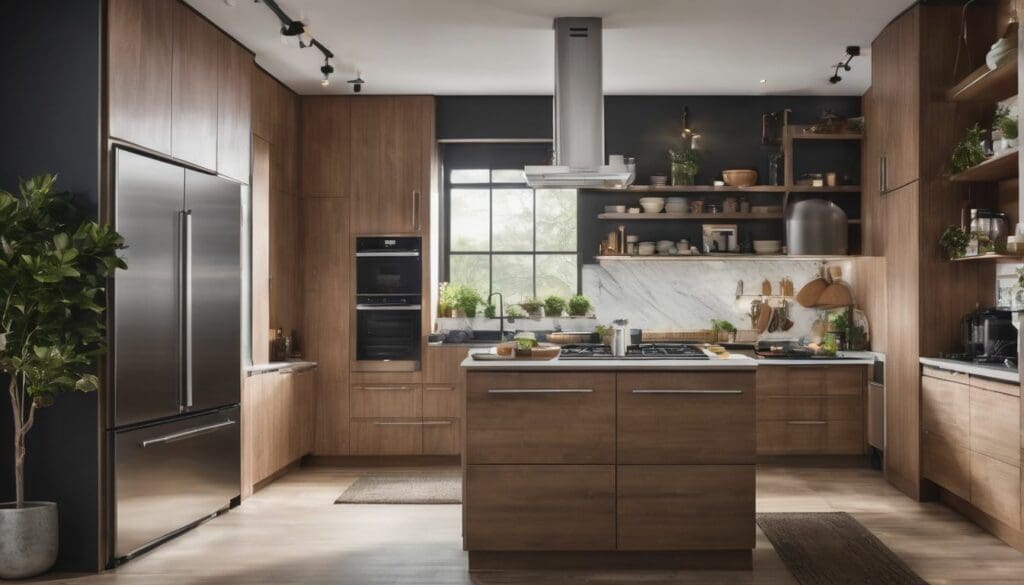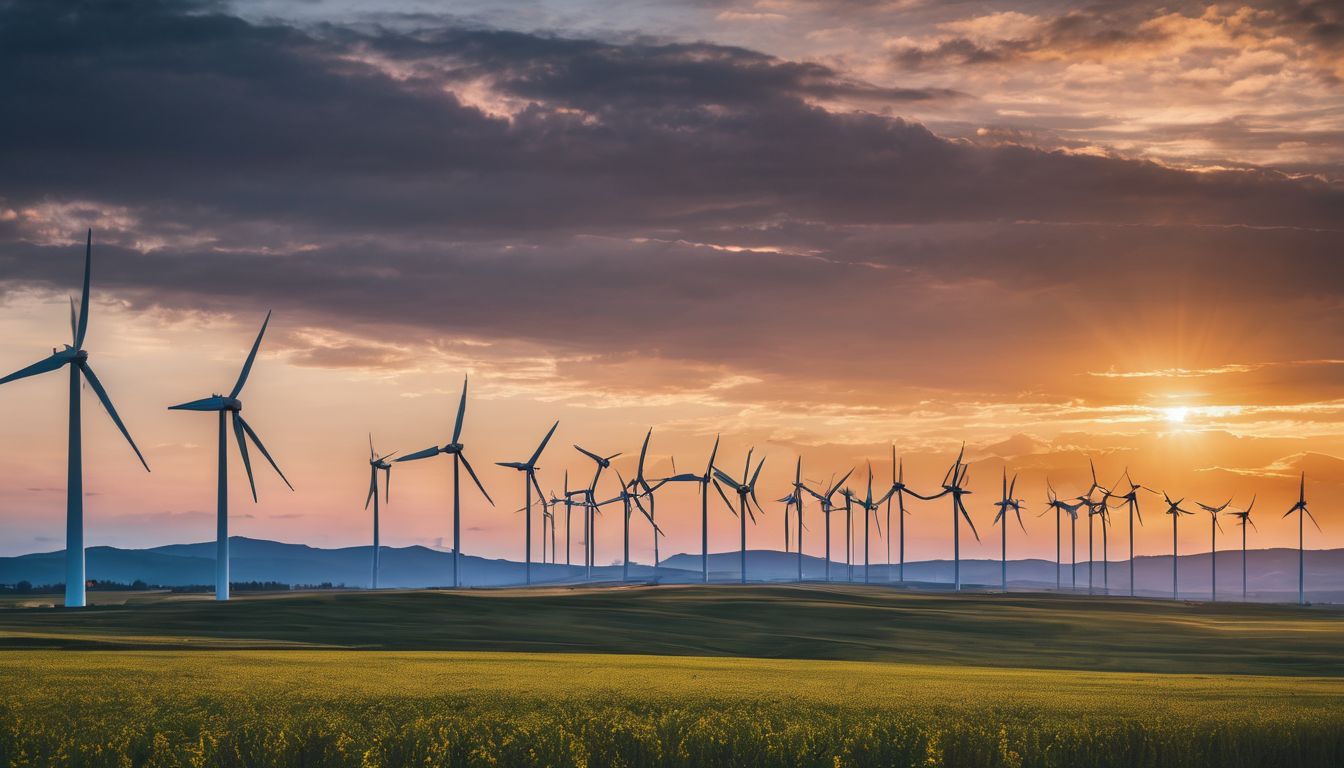Facing the squeeze from soaring energy costs is a common tale of late – it seems everyone’s feeling it. Rest assured, we’re navigating these choppy waters alongside you. Our own bit of sleuthing has revealed that, on average, a household could pocket savings of as much as £250 each year by embracing more environmentally conscious practices.
Why not join us at our workshop where we’ll guide you through the process of converting your home into a haven of energy efficiency? We promise it won’t cost the earth. Together, let’s roll up our sleeves and pave the way to a greener tomorrow—read on for insights!
Key Takeaways
- Conducting a home energy audit is the first step to identifying where you can save on bills and reduce your carbon footprint. This involves checking insulation, inspecting windows, assessing appliance efficiency, and considering renewable energy options.
- Upgrading your home with eco-friendly improvements such as LED lighting, Energy Star-rated appliances, and efficient doors and windows can lead to significant reductions in energy use and cost savings over time.
- Solar panels offer a renewable energy source that diminishes reliance on fossil fuels; federal grants may be available to help fund these installations for homeowners eager to make sustainable changes.
- Employing green design practices within your home decor, like opting for low-VOC paints or recyclable materials for furniture, contributes positively to both indoor air quality and environmental conservation efforts.
- State and provincial grants provide financial assistance for weatherization improvements while DIY efforts like fixing leaks or composting can further downsize one’s ecological footprint without major expenses.
Evaluating Your Home’s Current Energy Usage
Let’s start by conducting a thorough home energy audit to identify areas for improvement. This will help us determine where we can make the most impact in reducing our energy usage and environmental footprint.
Conduct a Home Energy Audit
We’re guiding you through a home energy audit to pinpoint where you can make eco-friendly improvements. Together, we’ll cut down on energy consumption and aim for sustainable living practices.
- Schedule an appointment with a professional auditor. They bring tools and expertise to assess your home’s energy flow.
- Gather your past utility bills. Reviewing these documents helps us understand your historical energy usage.
- Inspect windows and doors for drafts. Sealing gaps can significantly reduce heating and cooling costs.
- Check insulation levels in the attic and walls. Proper insulation keeps the warmth inside during winter and outside during summer.
- Evaluate the age and efficiency of your heating and cooling systems. Upgrading to modern, more efficient models can lower energy bills dramatically.
- Examine lighting fixtures throughout the house. Switching to LED bulbs offers one of the quickest returns on investment.
- Assess appliances for energy efficiency ratings. Consider replacing older models with Energy Star-certified machines that consume less power.
- Look at water usage patterns. Installing low – flow toilets and showerheads reduces water consumption effortlessly.
- Investigate potential leaks in ductwork or piping systems. Fixing these ensures maximum efficiency from your heating, cooling, and plumbing.
- Explore options for renewable energy solutions, such as solar panels or wind turbines.
Identify Areas for Improvement
After conducting a home energy audit, we noticed some areas that could benefit from improvement in terms of energy efficiency. The audit highlighted potential upgrades such as replacing old windows and doors with more energy-efficient options, adding insulation to improve the home’s thermal performance, and upgrading to Energy Star-rated appliances.
These simple changes can significantly reduce energy consumption and contribute to a greener living environment.
Moreover, the evaluation revealed opportunities for enhancing lighting fixtures by transitioning to energy-efficient LED bulbs or installing solar panels for renewable power generation.
Eco-Friendly Home Upgrades
When it comes to eco-friendly home upgrades, there are a range of options available. From energy-efficient lighting and solar panels to insulation and window upgrades, making these changes can significantly reduce your carbon footprint.
Making these sustainable home improvements not only benefits the environment but also saves you money in the long run.
Energy-Efficient Lighting
When upgrading to energy-efficient lighting, consider using LED bulbs which consume less power and last longer. These bulbs are an easy and cost-effective way to reduce energy usage within the home, contributing to a lower ecological footprint.
Additionally, installing dimmer switches can provide greater control over the amount of light used in different rooms, further saving on electricity consumption.
By choosing eco-friendly lighting options, individuals can create a more sustainable living environment while reducing their overall energy costs. LED bulbs and dimmer switches are simple yet effective steps towards an eco-conscious home makeover that supports conservation efforts and promotes a greener lifestyle for everyone involved.
Solar Energy
Solar energy is a sustainable and renewable source of power. Solar panels harness sunlight to generate electricity, reducing the reliance on non-renewable resources. These panels are typically installed on rooftops or in open areas to capture maximum sunlight.
The captured solar energy can be used to power various appliances and lighting within your home, contributing to a reduced ecological footprint.
By installing solar panels, homeowners can enjoy long-term cost savings on their electricity bills while also supporting environmentally friendly practices. Additionally, governmental incentives and grants often exist to assist with the initial investment of solar panel installation, making it an attractive option for those interested in green home renovations.
Energy-Efficient Appliances
After investing in solar energy, another way to make your home more eco-friendly is by upgrading to energy-efficient appliances. These appliances are designed to consume less energy while providing the same level of performance as traditional ones.
By investing in energy-efficient refrigerators, stoves, washing machines, and other household appliances, you can significantly reduce your carbon footprint and contribute to a sustainable lifestyle.
Upgrading to Energy Star-rated appliances ensures that you are making an environmentally friendly choice while also saving money on utility bills.
Window and Door Upgrades
Upgrading windows and doors is a significant step in creating an energy-efficient home. By replacing old, draughty windows with double or triple glazed ones, we can reduce heat loss and enhance insulation.
Installing energy-efficient doors equipped with weather stripping and proper sealing also contributes to maintaining a sustainable indoor environment by preventing heat from escaping during winter and cool air from leaking out during summer.
These upgrades not only help conserve energy but also contribute to reducing utility costs while creating a more comfortable living space.
Choosing eco-friendly materials for window frames such as wood or fibreglass supports the use of sustainable building materials, further aligning your home makeover with environmentally conscious practices.
Moreover, integrating features like low-emissivity glass in window upgrades enhances energy efficiency by minimising ultraviolet and infrared light penetration, thereby reducing solar heat gain within the house.
Insulation
Insulating our homes is a crucial step in reducing energy consumption. Proper insulation helps keep our homes warm in winter and cool in summer, reducing the need for excessive heating or air conditioning.
By using eco-friendly insulation materials like cellulose, wool, or recycled denim, we can lower our ecological footprint while creating a more comfortable living environment. Insulating lofts, walls, and floors also helps to maintain a consistent indoor temperature and reduce overall energy usage.
Using natural materials such as straw bales or hempcrete for insulation not only improves energy efficiency but also promotes sustainable home design. These materials are renewable and have low environmental impact throughout their life cycle.
Sustainable Home Decor and Landscaping
When it comes to sustainable home decor and landscaping, we’ll explore using eco-friendly materials and products, incorporating green design practices, and creating a green garden.
Let’s dive into ways to make your home both beautiful and environmentally friendly!
Using Eco-Friendly Materials and Products
To create an environmentally friendly home, you can start by using eco-friendly materials and products. Look for sustainable options such as bamboo flooring, reclaimed wood furniture, and recycled glass worktops. Consider low-VOC paint for your walls to minimise indoor air pollution. Utilise natural fibres like organic cotton and hemp for upholstery and bedding. Select energy-efficient appliances with the Energy Star label to reduce electricity consumption. Opt for eco-friendly cleaning products made from natural ingredients like vinegar and bicarbonate of soda. Choose water-saving fixtures and fittings to conserve water usage in your home. Incorporate solar-powered outdoor lighting to reduce reliance on electricity. Additionally, consider installing a rainwater harvesting system to irrigate your garden sustainably.
Incorporating Green Design Practices
Incorporating green design practices is essential for creating an eco-friendly home. Choosing sustainable materials, such as reclaimed wood or bamboo flooring, can significantly reduce the environmental impact of your renovation project.
Utilising energy-efficient windows and doors not only enhances insulation but also reduces energy consumption. Installing a rainwater harvesting system or utilising low-flow fixtures supports water conservation efforts.
Additionally, incorporating natural lighting through skylights and strategically placed windows decreases the reliance on artificial lighting.
Implementing green design practices does not have to be daunting; small changes can make a big difference in reducing your ecological footprint. Opting for non-toxic paint and finishes ensures better indoor air quality while supporting eco-friendly decorating choices.
Creating a Green Garden
Let’s explore how to create a green garden that promotes sustainability and reduces your ecological footprint:
- Choose native plants that require less water and maintenance.
- Implement rainwater harvesting systems to water your garden.
- Use organic fertilisers and pesticides to maintain a chemical-free environment.
- Incorporate composting bins to reduce waste and nourish the soil.
- Plant trees strategically for shade and energy efficiency in your home.
Funding Options for Eco-Friendly Home Makeovers
Exploring various funding options can help individuals make eco-friendly home upgrades without breaking the bank. From federal grants to DIY tips, there are several avenues to explore when seeking financial assistance for sustainable home improvements.
Federal Grants
To support environmentally conscious individuals looking to reduce their ecological footprint, here are some sources for federal grants that can help fund eco-friendly home makeovers:
- Investigate available grants from the Environment Agency to support your eco-friendly home makeover project.
- Explore funding opportunities from the Department for Business, Energy & Industrial Strategy to assist with energy-efficient upgrades and sustainable home renovations.
- Consider seeking financial support from the National Lottery Community Fund for initiatives aimed at reducing energy usage and promoting eco-conscious living practices.
- Look into potential grants from the Department for Environment, Food & Rural Affairs (DEFRA) for projects focused on incorporating green building materials and environmentally friendly home improvements.
- Research grant options provided by local councils or environmental agencies in your area to fund energy-efficient upgrades and eco-friendly decorating initiatives for your home.
State and Provincial Grants
To support eco-friendly home makeovers, state and provincial grants offer financial assistance. These grants are available for homeowners looking to reduce their ecological footprint and embark on energy-efficient upgrades. Here are some prominent state and provincial grants:
- Renewable Energy Initiative Grants: These grants promote the installation of renewable energy systems such as solar panels, wind turbines, or geothermal heat pumps. They help homeowners switch to sustainable energy sources.
- Weatherisation Assistance Programmes: These programmes provide funding for improving the energy efficiency of homes through measures like insulation, weather stripping, and other home upgrades that reduce energy consumption.
- Sustainable Landscaping Grants: Some states and provinces offer grants for creating natural landscape exhibits in residential areas. This includes native plant gardens, rain gardens, or green infrastructure projects that contribute to environmental conservation.
- Energy-Efficient Appliance Rebates: Certain regions provide rebates for purchasing ENERGY STAR certified appliances, encouraging homeowners to opt for more energy-efficient options.
- Green Building Incentive Programmes: These programmes focus on promoting environmentally friendly construction practices by providing grants for eco-conscious home improvements.
- Low-Interest Green Loans: Some areas offer low-interest or zero-interest loans specifically tailored for funding eco-friendly home renovations and enhancements.
DIY Tips to Reduce Ecological Footprint
To reduce our ecological footprint, we can make simple changes in our daily lives. These small adjustments can have a big impact on the environment. Here are some practical DIY tips to help minimise our ecological footprint:
- Reduce water usage by fixing leaks and installing low-flow fixtures.
- Use reusable shopping bags and containers to cut down on single – use plastics.
- Compost food waste to decrease landfill contribution and create nutrient-rich soil for gardening.
- Opt for energy – efficient appliances to conserve electricity and lower carbon emissions.
- Choose public transport, carpooling, cycling, or walking instead of driving alone.
Conclusion
In conclusion, making eco-friendly upgrades to your home can significantly reduce its environmental impact while also saving you money in the long run. By evaluating your current energy usage and implementing energy-efficient upgrades, such as solar panels, insulation, and energy-efficient appliances, you can greatly decrease your ecological footprint.
Sustainable decor and landscaping choices add another layer of eco-consciousness to your home makeover, incorporating green design practices and using environmentally friendly materials.
Additionally, exploring funding options like federal and state grants can help offset the initial investment for these renovations. With a combination of mindful living practices and intentional environmental renovations, you can create an earth-friendly home that aligns with your values of conservation and sustainability.
FAQs
1. What is an Eco-Friendly Home Makeover Workshop?
An Eco-Friendly Home Makeover Workshop teaches you how to make eco-conscious home improvements, including eco-friendly renovations and energy-efficient upgrades.
2. How can I reduce my home’s ecological footprint?
You can reduce your ecological footprint by adopting energy-efficient living practices, such as installing energy-saving features and opting for earth-friendly home design.
3. What are the benefits of conducting eco-friendly house renovations?
Eco-friendly house renovations help lower your energy usage, save money on utility bills, and support a healthier environment.
4. Can you learn about decorating in an environmentally friendly way at this workshop?
Yes, our workshop covers eco-friendly decorating tips that enhance your home’s aesthetics while being kind to the planet.
5. Will the workshop teach me how to evaluate my current energy usage?
Absolutely! You’ll learn how to conduct an energy usage evaluation so you can pinpoint where to focus your ecofriendly renovations for maximum impact.





